In the mid 1500’s Austria was considered to
be a major European power. Its empire extended from Switzerland
to Hungary, Bohemia and Croatia.
During this period Austria relied heavily on the horse for the
army, for politicians, clergy, farming of course and… where
our story begins…. The Hapsburg Court |
|
| QUALITY |
| Spanish horses were always regarded as among
the best available in Europe and large numbers
were crossed with many other breeds in order to
produce quality animals that were best suited
for whatever purpose they were produced for. The
Hapsburg Dynasty established a number of its own
independent breeding studs in order to produce
superior horses for the Court of Vienna and
quality horses to support the growing postal
network. |
|
|
| ARCHDUKE OF AUSTRIA |
| When Charles, son of Emperor Ferdinand 1,
became Archduke of Austria , he took steps to
ensure that a steady supply of quality horses
would be available for both military and
civilian purposes. He studied many areas for a
suitable site to establish the Imperial Court
stables. He chose an Episcopal estate in a small
village by the name of Lipizza, which lies 1300
feet above and to the northwest of the harbour
city of Trieste in what was later known as
Yugoslavia |
 |
|
Archduke
Charles II |
|
|
 |
The height of the Lipizza plains, combined
with its close proximity to the sea produces a
mixed climate of cool Continental and warm
Mediterranean, thus making ideal conditions for
the vegetation which grows profusely in the
areas where water is available. Summer
temperatures can reach more than 90 F. In Winter
the Karst Bora winds can blow for months. Tough
conditions in both extremes. |
|
|
|
| TYPE |
|
Karst is the name originally
given to the landscape bounded by the Bay of
Trieste but it is often used to describe a type
of countryside not necessarily in the
Balkans.Lipizza itself was surrounded by dense
forests of limes, maples and oaks |
|
|
| LIPIZZA |
 |
| No one knows for sure how Lipizza aquired its
name. According to historians it is of Slovene
origin and probably derives from ‘mule lipa’
meaning ‘small lime’. Another theory is that
Lipizza derived its name from a little house
called Pod Lipico (meaning ‘under the small
lime’). The house had a wine shop where the
locals would call in for a K-Lipizza which means
refreshment. |
| There is a lot of confusion as
to how to spell the name or indeed how
to pronounce it. Let me try and explain: |
|
|
Lipizza is
the Austrian spelling of the name. When
the stud was first formed, it was called
Lipitza. This was later changed
by the Hapsburgs to Lipizza. This
spelling and pronunciation was accepted
and its use was continued by the
Italians.In more recent times, the
Slovene spelling of Lipica tends
to be used |
|
|
|
| THE BEST |
| Lipizza’s landscape of steep
rock faces was used by the ancient Romans as a
breeding area for superior war and ceremonial
horses. More than one thousand years later, many
medieval knights came to the area to obtain
their noble mounts. The area was a tried, tested
and proven breeding ground for quality horses |
| On 9th May 1580 Archduke
Charles II, who held court at Graz as
Regent of Styria, Carinthia, Carniola
and Istria purchased the Lipizza Estate
and arranged for 24 Karst Mares from the
Episcopal Stables to be immediately sent
there. He then searched for the best
stallions possible and considered the
horses of Andalusia to be particularly
suitable due to their fiery looks and
high intelligence. He arranged for 9
stallions from Andalusia and other
carefully selected regions of Spain to
be imported to Lipizza in order to form
the first Imperial Herd to be based on
the newly purchased estate. |
|
| Horse breeding in Spain was generally
considered to be far in advance of its
neighbours and the countries of Europe
purchased Spanish stallions in large
numbers in a bid to improve their
various breeding herds. Archduke Charles
II held such a view and particularly
favoured the Studs of Frederiksborg in
Denmark and Naples in Italy who were
later particularly credited with being
among the foundation centres of the
Lipizzaner Horse. |
|
| So traditionally, 1580 is the
year of the foundation of the Lipizzaner
Horse. |
| The horses of Lipizza were bred to be
noble and elegant as they were intended
for court ceremonial duties in Vienna. |
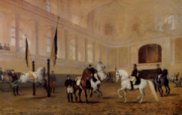 |
|
Morning
excercise in 1890 by JuliusVonBlaas |
|
| The Imperial ‘Hofreitschule’ in
Vienna, became known as the Spanish
Riding School because the stallions of
Lipizza who came there for training were
derived almost exclusively from Spanish
lines. |
|
| The stud progressed well and so had to
be enlarged. In the early 1700’s,
Italian, German and Danish sires were
introduced into Lipizza. The Italian
horses, wherever their origins, had
Spanish bloodlines. When the Spanish
lines depleted, oriental sires were
introduced with some success. |
|
| By the reign of Empress Maria Theresia,
150 brood mares of all colours were
resident in Lipizza. For generations,
Lipizza developed in peaceful
surroundings and was known to produce
some of the finest horses in Europe. |
|
|
|
| WAR |
|
But – war was never far
away, and in 1793 Austria & Prussia entered
the First War of Coalition. This was soon
followed by the wars between Austria &
France - The Napoleonic Wars. Instability
coupled with uncertainty spread throughout
Europe.In January 1797 a fierce battle was
fought and Napoleon penetrated Styria and
Carinthia. The centre of the Hapsburg heartlands
was threatened. Hostilities came perilously
close to Lipizza and the Lipizzaners were
evacuated on the morning of 22nd
March 1797. |
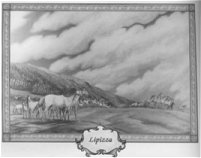 |
|
A.A.
Lipizza & War |
|
|
During the march, 16 mares foaled
and all survived.In November 1797, the evacuees
returned to Lipizza only to find the stables in
ruins. They rebuilt them industriously and
enjoyed a few years of calm – but alas, it was
not to continue because nature decided to
intervene this time. |
|
|
| EARTHQUAKE |
| On 4th January 1802 an earthquake
shook the Lipizza stud to the ground. The
industrious staff again set about the task of
rebuilding and again a few years of peace
ensued. |
|
|
| WAR AGAIN |
| But – Austria and France’s fragile peace
broke once again and Napoleon advanced into
Vienna in 1805 and by the afternoon of 14th
November a quarter of the Palace of Schonbrunn
had been taken by his Army. |
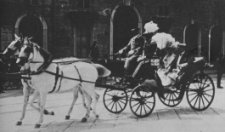 |
| Archduke
Ferdinand and his wife Sophie
ride to Trieste in a carriage
drawn by Lipizzaners. |
| Soon
after he was assassinated in
Sarajevo in 1914 and thus began
World War 1 |
|
|
| Thee horses of Lipizza were evacuated
once again. This time they headed for
Djakovo and then on to Karad where they
spent a year in exile. On 1st
April, 1807 they again started on the
long journey home to Lipizza.For two years they were at peace and
breeding was again under way- but then
more trouble. |
| The ‘Peace of Schonbrunn’
resulted in the separation of Carniola,
Trieste, a section of Carinthia and the
Duchy of Gorizia from the Hapsburg
Empire. The inhabitants of Lipizza were
expected to live as foreigners in their
own homeland or get out. |
|
| So, the third trek to Hungary began. |
|
|
|
| THIRD EVACUATION |
| The horses of the Lipizza Stud had to be
evacuated three times during this unsettled
period. Hungary was the host each time and cared
well for its treasured equine guests. |
|
| This third flight into Hungary was by far the
worst. 289 horses took 46 days to reach their
destination in the Hungarian Pecska. Three foals
were born during the march and one died. Their
exile lasted for six years and the horses had to
endure boggy conditions which they were not used
to in Lipizza. Feed and water quality was not up
to their requirements and sickness was rife. 27
of the 110 mares aborted and consequently the
stud was considerably weakened although it is
now generally felt that no lasting damage was
sustained. |
|
|
| STUD BOOKS LOST |
| In the meantime in Lipizza, Napoleon reigned
devastation on the karst lands. The centuries
old forests were cut down and the country’s
treasures were taken. All of the stud books in
Lipizza up until 1700 were rifled and lost to
the world forever. |
|
|
| MEANWHILE |
| The Lipizzaner stallions in Vienna meanwhile
were thrilling the heads of Europe with a
magnificent carousel in sharp contrast to the
Lipizzaners of Lipizza, about to leave their
shelter. |
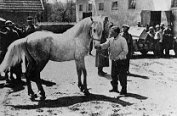 |
|
Hostau
soon after the arrival of the US troops
for the rescue of the Lipizzaner herd. |
|
| Not all of the stock evacuated from
Lipizza’s forced exiles returned and
it is for this reason that Lipizzaners
directly from Lipizza were to be found
in all of the states of the |
| Hapsburg
Monarchy, which included former
Yugoslavia, Hungary, Czechoslovakia and
Rumania.
|
|
|
| PRINCIPAL |
| Lipizza however remained the principal stud
for producing ceremonial horses for the Imperial
Court of Vienna. |
|
| In the early nineteenth century, grey horses
were in favour and careful selection within the
Lipizzaner herd resulted in a predominance of
white horses, which is still very much the case
today in the 21st century. |
|
|
| 100 YEARS OF PEACE |
| So, a century of peace was in progress and not
even the fatal shooting at Sarajevo which
heralded the start of the First World War
interrupted the peaceful surroundings of the
Lipizzaner’s Karst homeland. |
|
|
| WAR AGAIN |
| Fate took a hand on 18th May 1915,
which was the first year of World War 1
hostilities. Italy entered into secret
negotiations with the Entente and in return for
concessions on certain of its territories it
agreed to enter the War on the side of the
Allies. As a consequence the Vienna Court
ordered its valuable breeding herd out of
Lipizza as it was in danger of being fought over
by the warring neighbour countries. |
|
So, on the evening of
18th May, 1915 the
Lipizzaners once again set forth for
exile. A section of the stud moved to
Laxenburg near Vienna and another part
went to Kladrub in Bohemia, which at
that time was still part of the
Austro-Hungarian Monarchy. This exile
proved disastrous for the breeding
programme, limited though it was.
Fertility fell from around 80% to a
shockingly low 10%. |
|
| For 340 years, 14 Hapsburg Emperors
had been supplied with beautiful riding
and coach horses from Lipizza. No one
believed, as they again left the Lipizza
Stables for exile, that they would never
return to the homeland of the noble
animal who took its name from the
karstland of its ‘birth’. |
|
|
|
| COLLAPSE OF THE HAPSBURGS |
| In November 1918, the Hapsburg Monarchy
collapsed and was divided into a number of small
states. These new states soon began a battle for
ownership of the Lipizzaner herd and wrangling
went on for months before finally a decision was
reached and the fine herd of Lipizzaner horses
was divided between Italy and the new Austrian
Republic. The 97 animals awarded to Austria were
sent to Laxenburg Castle near Vienna. They
remained there for a short period of time and
were then transferred to a renaissance Manor in
the village of Piber which is just outside Graz,
capital of Styria in Southern Austria. An
Imperial Stud had been in situ at Piber since
the late eighteenth century. |
|
|
PIBER
 (The Piber Brand)
(The Piber Brand)
| The Piber Stud was founded in 1798
under Emperor Joseph II. It developed
into a stud for the breeding of military
horses and was well known for producing
English half breds and Anglo- Normans
for use in the Royal Austro-Hungarian
and Imperial Army. |
|
| Fine though the Piber State Stud was,
its future for a time after the collapse
of the Hapsburg Monarchy was in serious
doubt. Hunger amongst the people of
Austria was rife and no one was really
interested in the breeding of Imperial
Horses. ‘For what?’ they asked. ‘What
about feeding the people?’
The
problem was passed from one ministry to
another with the Minister of Culture and
the Minister of War both refusing to
take responsibility for the horses. |
|
|
|
| SAVED |
| The Minister of Agriculture, who was a farmer
by profession, decided to personally intervene
and he agreed to take responsibility for the
precious waifs and thus Piber was saved and with
it the Austrian Lipizzaner. |
|
|
| WORLD WAR II |
| When World War II broke out, the Piber Stud
was requisitioned by the German Army. The Army
turned the stud into a breeding centre for
military horses and it was also used to produce
mules for transporting goods in mountainous
regions. |
|
|
| EXILE
AGAIN
|
|
 |
|
General
George Patton |
|
| Between the years of 1941 and 1942 Piber’s
Lipizzaner mares were sent to Hostau in Bohemia. |
| Their rescue from Hostau by a unit of General
Patton’s Army in May 1945 under the command of
Colonel Reed is a well documented period of the
Lipizzaner’s, and indeed World War II’s
history |
|
| WAR OVER – peace at last |
| Eventually, the requisitioned horses were
returned to their rightful countries and the
Austrian Lipizzaners came back to Piber, the
only state owned stud in Austria, and which was,
and still is, under the administration of the
Austrian Federal Ministry of Agriculture and
Forestry. Piber’s pastures mirrored those of
the Lipizzaner’s original home in Lipizza and
were ideally suited to continue the traditional
breeding of this noble aristocrat. The stud was,
as mentioned earlier, an important military
breeding centre, so re-introducing the precious
Lipizzaner herd was relatively trouble free |
|
|
| CASTLE |
| The administrative part of the stud was housed
in the old castle. Its design was the work of
Domenico Sciassia, a famous architect of the
time. It was built between 1696 and 1728.
Unfortunately for us in this time period,
practically nothing remains of the former
building and all we have left are fine drawings
of the time. |
| The reason for this apparent
destruction of fine architecture is a serious
fire coupled with many renovations over the
years. |
|
| The Lipizzaner herd flourished in
Piber’s pastures and fertility was
high. Development was smooth and trouble
free. |
|
|
|
| CATASTROPHE |
|
Then – catastrophe struck .
In 1983 an epidemic of Equine Herpies broke
out.In the Spring of that year, the herd of
around 50 mares were, as normal, due to give
birth. The first foals were born dead, and then
many of the mares suffered miscarriages. |
|
| Although stringent measures were immediately
taken, the Piber stud lost 8 precious mares and
most of that year’s crop of foals. |
|
| Questions were asked about inbreeding at the
stud, as the breeding programme up until then
had been based on the 6 classical stallion lines
which derived from stallions produced in the 18th
century, and no ‘out-crosses’ to Lipizzaners
in the other old State Studs of Europe were ever
used. |
|
|
| MANY STUDS |
| During the reign of the Austro-Hungarians,
there were many Lipizzaner studs in the Empire
and they were all directed and supervised from
Vienna. Exchanges between the studs were
frequent, thus allowing the gene pool to remain
open and large enough for inbreeding to be
avoided or kept to a minimum |
|
| When the Empire was dissolved into small
regions in 1918, the various studs remained, but
their aims headed in various directions
depending on what their different ideals were.
Some desired better carriage horses, others gave
higher priority to working horses and some
strove for better riding horses. |
|
| Even though the original ancestors were common
to all, the physical characteristics began to
change according to the criteria of each stud. |
|
|
| SCHOOL STALLIONS |
| The Piber Federal Stud continued to be the
source from which The Spanish Riding School of
Vienna obtained their mounts. Only the best
School Stallions were allowed to pass on their
precious genes to the next generation. Two,
maybe three School Stallions would service a
herd of around fifty mares for three or four
years. |
|
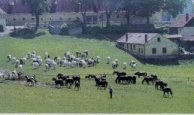 |
|
The
mare herds at piper can now be serviced
by stallions from a wider gene pool than
at any other time in history. |
|
|
| It remains speculative as to whether the
outbreak of herpies which resulted in such a
disastrous loss happened as a result of
inbreeding, but it was widely debated on a
worldwide level Speculation was public &
rife and it resulted in a decision to revise the
breeding programme to allow the infusion of
blood from other studs. |
|
| An exchange programme was worked upon,
overseen by the veterinary surgeon who is widely
credited with saving the Piber herd – Dr
Jaromir Oulehla. |
|
| Dr Oulehla was appointed not only Director of
Piber but also of the Spanish Riding School
itself. |
|
|
The first time in the history
of the Austrian Lipizzaner that this had
occurred .Dr Oulehla was also the first civilian
to hold such posts. |
|
| He immediately set about releasing more of the
School Stallions to Piber for stud work and
entered negotiations with other State Studs of
the old Austro Hungarian Empire for exchanges of
sire lines and purchase of mares. |
|
|
| COMPLETE TO 1700 |
| As stated earlier, the stud books of the
Lipizzaner are complete back to around 1700 and
the ancestry of the Lipizzaner can be accurately
traced to at least that time. Dr Oulehla’s
purchases from the other state studs, along with
the sire exchanges, had to fulfil the criteria
of their ancestry being traceable, without
break, to 1700 |
|
| No blood from other breeds was introduced and
so the Lipizzaner ancestry remained pure. |
|
| The operation was a success and the Lipizzaner
of Austria is now in a strong position with a
herd of around 100 brood mares achieving a high
reproductive rate of quality offspring. |
|
| Dr Oulehla had a top class veterinary clinic
installed with every conceivable facility at his
fingertips. Hygiene methods that would put a top
human hospital to shame were implemented and the
Lipizzaner of Piber responded by surpassing all
expectations and the birth rate soared. A baby
boom was under way. |
|
| So – after a long and gruelling journey
through time, the Lipizzaner is safe. |
|
|
| MEANWHILE, LIPIZZA |
|
Back we go in time to the end
of the Second World War. Lipizza was now in
Italian territory. The dissolution of Crown
Properties had been placed in the charge of
Baron Eugen Beck von Managetta and he retrieved
the horses from the dissolved estate at
Laxenburg. An agreement was reached and
ownership of the 17 brood mare families was
divided between Italy and Austria. On 16th
July 1919, 107 horses were moved to Italy and 97
remained at Laxenburg. |
|
| The Lipizzaners evacuated to Kladrub remained
there. No one claimed them and consequently they
formed the basis for the breeding herd of
Czechoslovakia. |
|
|
| DISREPAIR |
| After the end of the Second World War , the
Lipica Estate fell into serious disrepair. The
fields were uncared for and the forests were
untended. Major repair work had to be carried
out before the horses could be housed. |
|
| At the end of 1947 the stud was taken over by
the Ministry of Agriculture together with the
outlying farms which had once formed part of the
original complex. Work began in earnest to
repair the damage and disrepair. The rebuilding
work was almost completed by the end of 1949.
The Ministry then sent 54 horses to Lipica
including a few Arabs. By 1950, the Stud was
again operational with almost as many horses as
it had when Italy was in control. It however had
a lot of groundwork to do to re-establish the
Lipizzaner breeding programme. The main problem
was in finding quality stallions able to pass
superior genetic qualities to future
generations. One stallion who fulfilled these
requirements was 1116 Conversano Gaeta. Others
equally worthy were 650 Siglavy Savica, 188
Favory Sava 1 and Conversano Dubovina. These
stallions were regularly exchanged between
Lipica and other Yugoslavian studs. |
|
|
| HARD TIMES |
| Times however were hard for the stud as less
demand for horses resulted in a serious loss of
revenue vital for its existence. The army and
agriculture were now largely automated and
demand for horses continued to decline. Towards
the end of the sixties, a financial crisis was
looming. Serious thought was given to selling
all of the horses and closing the stud
permanently. |
|
|
| CONCERN |
|
Concern was so great that
even the Viennese Parliament were asking
questions and protests started appearing in
newspapers all over the World.It was the stud’s
380th anniversary and President Tito
who visited the stud earlier that year, took an
interest in its welfare and in the campaign that
had been mounted to keep the stud from closing.
His timely intervention resulted in the Lipica
Stud’s eventual survival. |
|
|
| SUCCESSES |
| By 1957 twenty six Lipizzazners were being
trained in the classical manner. The specialist
Milan Belanovic was appointed head of the Riding
School and was responsible for the stud’s
successful appearances in Vienna, Lipizza and
Aachen. |
|
|
| MORE PROBLEMS |
| But the stud, despite its successes, had to
sell off most of its horses in the sixties and
its riders were disbanded. Due to the dedication
of some of its staff, it managed to continue in
a smaller way and slowly, it started to again
regain strength. |
|
|
| MORE PROSPEROUS TIMES |
| In 1973 a large riding school was built with
over 1000 public seats. Traditional shows were
put on for tourists to the stud and apart from
entertaining the public these shows were also
used to train the horses. Its horses began to
compete Internationally. In 1974, Lipica
organised its first International dressage
championship. Twenty one horses took part from
Austria, Germany, Rumania, Switzerland and
Italy, plus those from Lipica itself. The riders
and horses of Lipica continued to gain
respectable placings in International
competitions including the Balkan Dressage
Championships where they always gained 2nd
or 3rd places with their Lipizzaner
stallions. |
|
|
| TOURISM GROWS |
| The tourist industry was encouraged and horses
were developed for all types of sport riding and
driving, including basic riding for pleasure. |
|
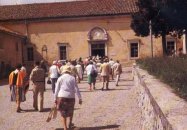 |
| Tourists
head for the Velbanca, one of Lipica's
oldest buildings. |
|
| These extra activities were necessary as it
was clear from the stud’s performance since
the war that it could not survive on breeding
and selling alone without substantial Government
subsidies. |
|
| By 1975 Lipizza had attracted 150,000
visitors. A new hotel was built in 1971 and it
was named after one of the founding Lipizzaner
stallions - Maestoso. |
|
| In 1979 a new stable complex consisting of 60
boxes was built with a riding school attached.
This school was intended for the use of horses
and riders under instruction. In that same year
a further hotel was erected for the exclusive
use of people who wished to predominately ride
.It was named the ‘Hotel Club’. |
|
| A racecourse capable of holding 10,000
spectators was also built and tennis courts were
constructed for the use of visitors. |
|
| While all this was going on the art of
classical riding was being taught and public
displays were in progress. |
|
|
| 400th ANNIVERSARY |
|
In 1980 Lipica prepared for
its 400th Anniversary. President Tito
agreed to act as sponsor for the festivities. |
|
|
Various cultural events were held but the major
spectacle was the revival of the old mail coach
on the Vienna-Trieste run. |
|
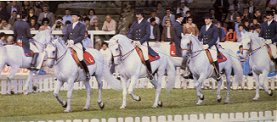 |
|
School
Quadrille on the 400th Anniversary
Celebrations in August 1980. |
|
| On 6th June, the coach, drawn by
four of Lipica’s brood mares, picked up a
mailbag at the Hoffburg in Vienna and started
out on its long journey to Lipica with a mighty
send –off from the gathered crowds. |
|
|
| THE LIPIZZANERS THROUGH FOUR CENTURIES |
| The highlight for the Lipizzaners of Lipica
was the display entitled ‘The Lipizzaners
Through Four Centuries’ which was held from 28th
to 31st August. This event was the
most important for the stud and for history. |
|
|
For the first time in 400
years, the Lipizzaners returned to the place of
their birth. Stallions from the Spanish Riding
School of Vienna came to Lipica for the first
time. |
|
| Some 245 years previously the Lipizzaners of
Lipizza had journeyed to the Spanish Riding
School to be trained and to perform in the
classical art of riding. |
|
| Lipizzaners from all of Europe’s major studs
took part in this magnificent spectacle, the
like of which can only be imagined if one was
not lucky enough to have witnessed it. The sight
of beautiful and elegant Lipizzaner horses from
all over Europe coming together to show off
their abilities seemed to unite everyone in
awesome pleasure. |
|
| Was the fighting really over? The Lipizzaner
had come home. |
|
|
| SZILVASVARAD |
|

|
If you have read the Story of the Lipizzaner
thus far, you will by now have realised that
Hungary has played an exceedingly important role
in the history of this noble animal. It is to
Hungary that the Lipizzaners fled during the
dark days of the European Wars. |
|
Szilvasvarad
Riding Logo
|
It was Hungary
that housed, fed, cared for and nurtured these
precious refugees. |
|
| So now you must learn a little
about the most important Lipizzaner stud in
Hungary – SZILVASVARAD. |
|
| The Hungarian Bukk Mountains
form the magnificent backdrop to the home of the
Lipizzaner of Hungary. |
|
| The town lies at the foot of the mountains,
famous for their abundance of wildlife which
include deer and wild boar, wild sheep &
polecat. Its bird population boasts such a
rarity as the Golden Eagle. In times gone by,
the bear was also a feature in the area but the
last one was shot over 100 years ago. |
|
| Szilvasvarad lies 456 metres above sea level
and was known to be inhabited in the times of
the cavemen! How do we know that? Well,
archeologists found the remains of a fireplace
built and used by the cavemen. They also found
cave bear and ice-age reindeer bones, mammoth
and prehistoric bison trunks. A big find was
paleolithic primitive tools of stone and bones. |
|
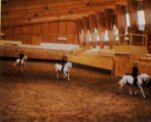 |
|
Szilvasvarad
Riding Hall |
|
|
| So, Szilvasvarad has seemingly always been a
favourite spot for man and beast and even today
it remains one of Hungary’s most popular
beauty spots. |
|
|
| LIPIZZANERS OF HUNGARY |
| The Lipizzaners of Hungary were bred with
great success for four centuries in Fogaras in
Transylvania until at the outbreak of World War
I they were moved to the well known arab stud in
the centre of Hungary - Babolna. |
|
| The decision to move the stud
to Szilvasvarad was taken because the area more
closely matched the conditions and quality of
ground in the original Lipizza stud in the Karst
Mountains. The material that the ground in the
Bukk Mountains consists of is Triassic limestone
which is why the area is so like the Karst. |
|
| Another reason for the move was the unique
vegetation, differing from types of vegetation
found in other parts of Hungary. Several types
of its grasses correspond to those found in
Austria. |
|
| Szilvasvarad has largely
escaped the ravages of the European wars and so
it has continued in peace and tranquility
through the years to produce quality horses. Its
Lipizzaners have been exported worldwide and
have been particularly successful in World
Driving Championships for many years. |
|
| Szilvasvarad also participates
in exchanges of Lipizzaners in order to minimise
the problems associated with inbreeding. It’s
stallions have been exchanged with all the top
studs of the old Austro-Hungarian Empire and it
is generally agreed that the Lipizzaners of
Hungary have helped to sustain and maintain the
breed through the centuries. |
|
| The stud has roomy boxes, stalls and a large
riding hall where exhibitions are held for
tourists to the stud. It has a complex of well
maintained buildings which are all within easy
distance of each other for ease of management. |
|
| It also consists of outlying farms where the
herds are grouped into sex and age and are all
watched over constantly by outriders. |
|
| The Lipizzaners of Szilvasvarad are in great
demand all over the world and due to the very
many competition successes this beautiful stud
has produced, this trend can only go one way.
Up. |
|
|
| MORE WAR? |
| There is one other war to
write about and that one occurred in modern
times. It broke out in what is now commonly
referred to as former Yugoslavia The Lipizzaner National Stud Book Association Chairman,
John Goddard-Fenwick, in conjunction with
Hildegarde Gekiere, Secretary General of the
Lipizzan International Federation played an
active roll in rescuing and providing aid for
the stricken Lipizzaners embroiled in this
wretched war.
|
|
|
| LIPIZZAN INTERNATIONAL FEDERATION |
| The other old state studs all
have played and continue to play, an important
role in the continued development of the
Lipizzaner . To ensure that a common goal
continues to be striven for , the Lipizzan
International Federation (LIF) was officially
launched in the year of the 400th
Anniversary of the Lipizza Stud. Its members
consist of not only the original old Austro
Hungarian State Studs, but also the many private
Breed Societies that exist throughout Europe and
beyond, including of course ourselves. |
|
| The Lipizzan International Federation is such
an important institution for the Lipizzaner of
today that it deserves its own section of this
story entirely devoted to its history,
importance and function. You will find it under
its title: |
|
|
LIPIZZAN
INTERNATIONAL FEDERATION (LIF) |
|
| and if you have come this far in the history
of the Lipizzaner with us, you should find it
compulsive reading. I found it compulsive
writing. |
|
|